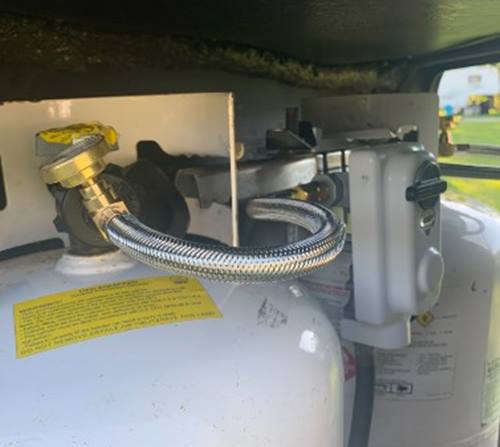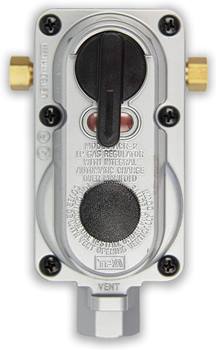How to Tell if RV Propane Regulator is Bad?


My family and I took a long RV journey last summer. One night, it got terribly cold; we tried to turn on the heater, but it didn’t work. The propane regulator in our RV was broken.
We searched online for signs of a faulty propane regulator and found several indicators. The heater wasn’t working properly, and the stove flames were unusual. We also heard a strange hissing noise near the gas tank.
We couldn’t afford to take it to a repair shop, so we opted to do it ourselves. We purchased a new propane regulator and followed the web directions. We plugged it in and switched on the propane, and guess what? We were warm because the heating was working again.
This incident taught us the importance of learning about RVs. In this blog, I will tell you how to recognize a bad RV propane regulator. If you like RVs, make sure you know how to check your propane regulator. It could save your trip from becoming cold!
Let’s get started!
Regular inspections and maintenance can help keep your propane system in good working order, giving you peace of mind on the road.
Not Getting Propane in RV — Bad Regulator?
Regulators can fail, resulting in symptoms such as extremely low or no fuel flow and even gas leaks if the tank is not turned off. Another problem could occur if the regulator pulls from one tank but not the other, even after manual switching. What could be the reason?
It could be caused by the regulator or the pigtail that connects the tank to the regulator. If both tanks are full and the valves are open, but there is still no propane flow, the problem could be a regulator or a jammed flow-preventing ball in the pigtail lines.
What are the possible reasons for a regulator to go bad?
The following are several reasons for a regulator to go bad.
- When subjected to low temperatures and high flow rates, propane regulators might provide difficulties.
- When the pressure in the regulator drops, it might cause chilling, resulting in apparent frost accumulation on the outside.
- While this frost is typically harmless, it can cause problems if it obstructs the atmospheric pressure reference vent or unduly insulates the regulator. It will cause the internal components to grow much colder.
- Oily impurities in propane may liquefy and interfere with regulator performance in extreme cold. Also, water might freeze in cold, thereby disturbing appropriate functionality and inflicting long-term harm.
- Furthermore, failing to turn off the propane tank can result in a substantial gas leak.
- Finally, if the regulator draws from one tank but not the other, the problem could be with the regulator or the pigtail that connects the tank to the regulator.
What are the Possible Reasons for a Regulator to Go Bad?
The following are several reasons for a regulator to go bad.
- When subjected to low temperatures and high flow rates, propane regulators might provide difficulties.
- When the pressure in the regulator drops, it might cause chilling, resulting in apparent frost accumulation on the outside.
- While this frost is typically harmless, it can cause problems if it obstructs the atmospheric pressure reference vent or unduly insulates the regulator. It will cause the internal components to grow much colder.
- Oily impurities in propane may liquefy and interfere with regulator performance in extreme cold. Also, water might freeze in cold, thereby disturbing appropriate functionality and inflicting long-term harm.
- Furthermore, failing to turn off the propane tank can result in a substantial gas leak.
- Finally, if the regulator draws from one tank but not the other, the problem could be with the regulator or the pigtail that connects the tank to the regulator.
Point to remember: If both tanks are full and properly valved but there is no propane flow, the issue could be with the regulator or the pigtail lines, which have a small ball mechanism that can occasionally become stuck during high flow.
What if the LP Regulator is Noisy?
The loudness is not a cause for concern and will not interfere with your enjoyment. It is the result of a change in the gas extraction process from both tanks. Regulators typically use a rubber diaphragm to control propane levels, which can generate a humming sound when it vibrates.
Why does this happen, though?
This noise could be caused by overfilling the propane tank or by high outside temperatures, as tanks should only be filled to 80%. If the buzzing continues and your tank isn’t overfilled, consider switching out the ‘pigtail’ hose lines for a quieter solution.
How to Check if RV Propane Regulator is Bad?
To ensure that your propane system runs smoothly, first check the propane detector in the trailer. If it is turned off, propane will not flow. Look for indications of a defective regulator, such as low or no fuel flow. The majority of propane repair locations can run a simple test for you.
What else can you do? Keep a watch on the propane levels in your bottles, since they drop quickly during leaks or furnace use. Because both tank OPD valves and pigtails failing at the same time are rare, suspect a malfunctioning regulator and verify gas in at least one tank.
Also, experiment by closing and carefully reopening tank valves. If there is no flow, consider a professional inspection or replacement of the regulator and pigtails.
How to Fix a Bad Regulator?
Use an automatic switchover system with red/green indicators to detect emptiness while checking your propane tank, and remember to refill empty tanks soon. If the gas is flowing too quickly, close the valve. After that, wait, and then slowly reopen it until you hear a click to pressurize the line.
Resolving the Safety Concern
Here’s how to solve the safety problem:
- Switch off both tanks.
- Turn on a stove burner to clear any gas or air in the lines (no open flames, please).
- Turn off all of your RV’s propane appliances.
- Connect both tanks to the regulator as usual after momentarily disconnecting them. This should clear any pressure in the lines as well as any safety triggers.
- If you have an auto-changeover regulator, set it to the maximum tank capacity.
- Slowly crack open the valve on your fullest tank and progressively open it until you hear a click or a gas rush. If you have a second tank, repeat the process. If you open it too quickly, the safety valve may snap shut.
- Check for leaks in all of your lines, regulators, and tanks.
- Light a barbecue lighter inside the stove and place it next to a burner to turn it on. You may initially get only air, but wait until it lights before lighting the other burners for roughly 30 seconds. Keep an eye out for any odd flames.
- Turn off the burners and restart the refrigerator as usual. You can proceed to the water heater, furnace, and other appliances once they run on propane without any alarms (this may take a cycle or two as the gas fills the pipe).
NOTES:
If you don’t obtain any air or gas when igniting the burners, this indicates a lack of flow. This could be due to a gas supply issue. In extremely cold temperatures, propane tanks may not function effectively, especially if they are nearly empty. Pouring hot water on the tank while avoiding the regulator can be beneficial.
Cold weather and low propane levels may cause the regulator and tank valves to feel quite chilly to the touch. If you have high-demand appliances operating, this can exacerbate the situation.
What if it Cannot be Fixed?

When you’re finished, make sure to obtain an extra regulator for your spare parts collection. They are not expensive. You can find a good propane gas regulator for RVs on Amazon like the Flame King (ACR6) LP propane gas regulator. It allows you to remove an empty cylinder easily, and also maintain good gas pressure under changing conditions.
Conclusion:
Finally, knowing how to spot the indicators of a faulty RV propane regulator is critical for the safety and efficiency of your propane system. By keeping a lookout for indicators such as poor appliance performance, gas leaks, or regulator damage, you can take immediate action to resolve any concerns and guarantee your RV trips are worry-free.
Also Read: Do I Need a Sway Bar for My Trailer? – Key Considerations